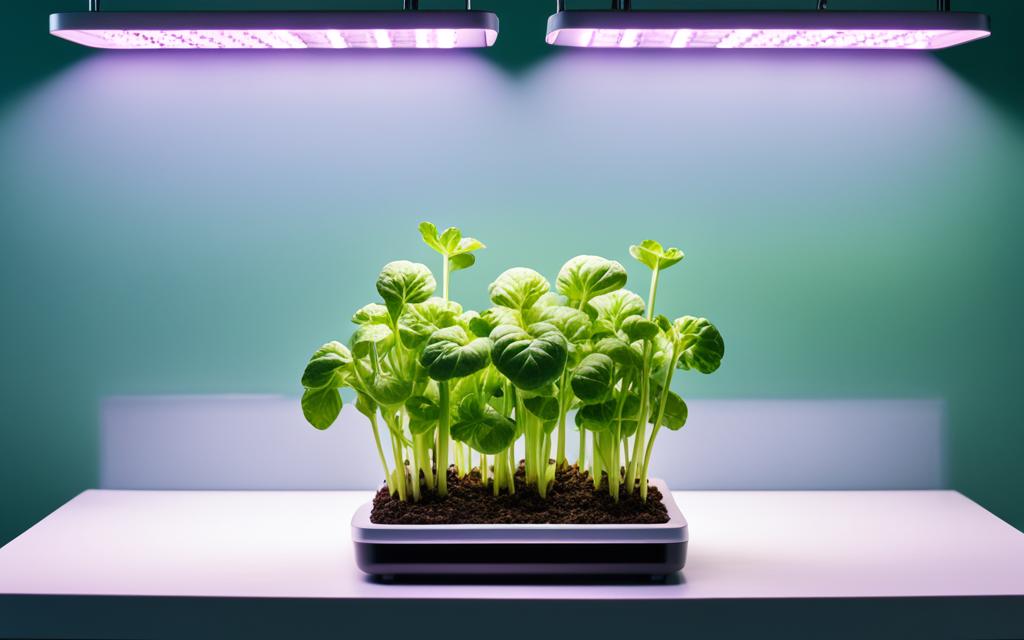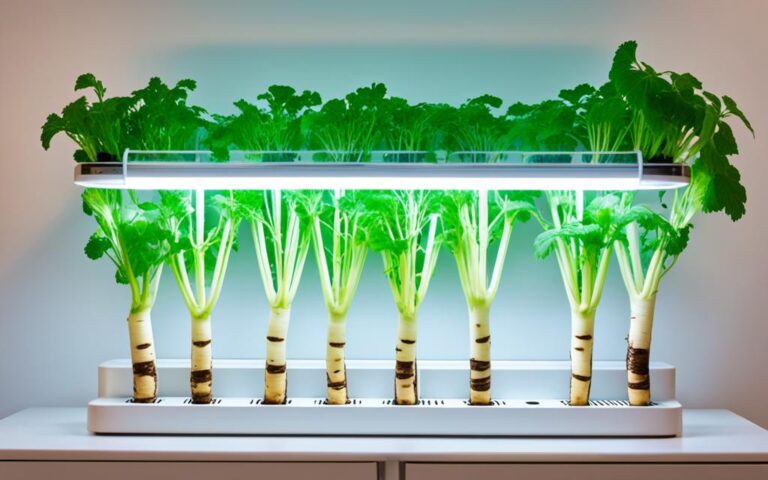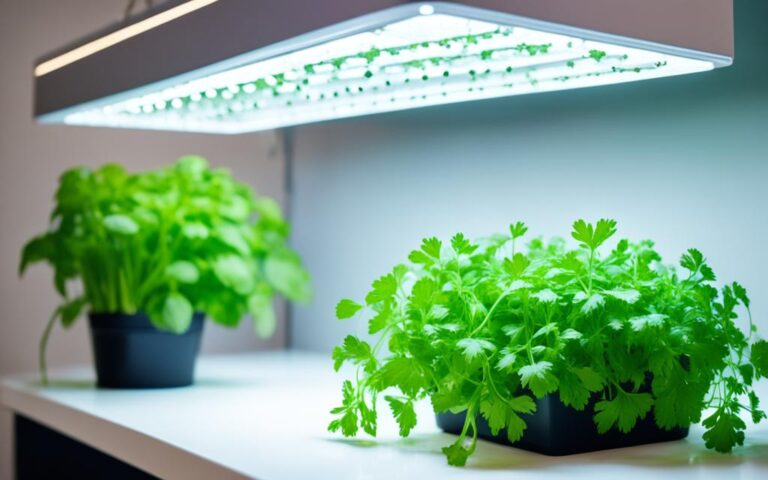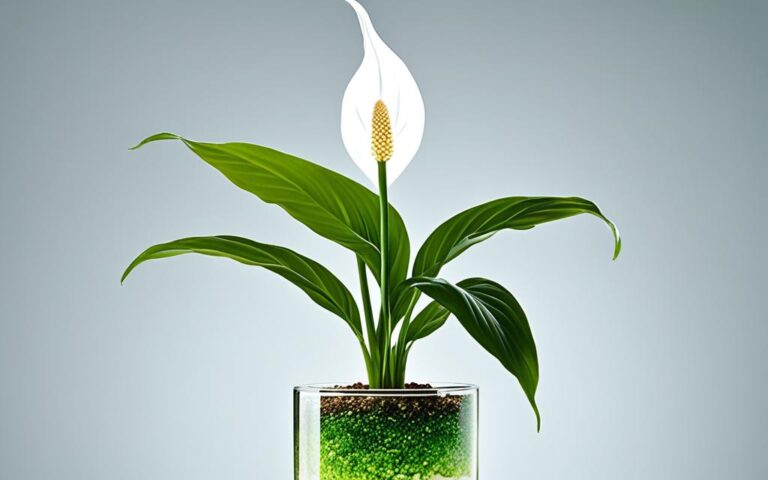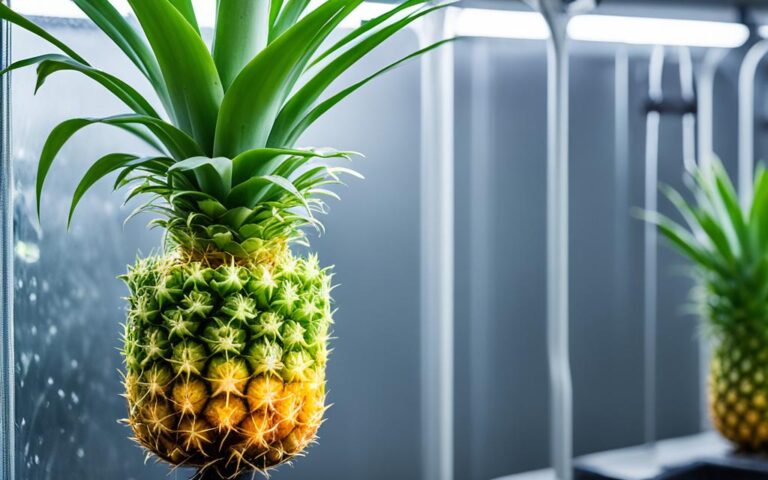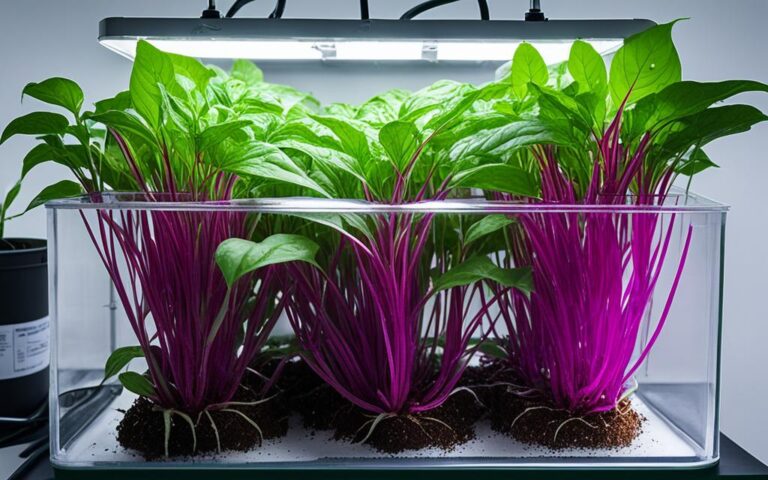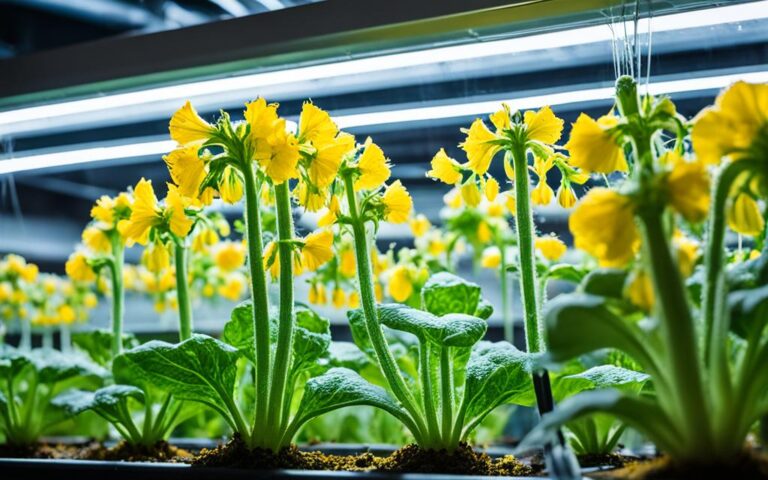Grow Hydroponic Brussels Sprouts at Home
Did you know hydroponic Brussels sprouts can produce up to 300% more than traditional methods? This method lets you grow more veggies without needing a big garden or rich soil. With hydroponics, you can have a steady supply of these healthy greens all year, right at home.
Key Takeaways
- Hydroponic Brussels sprouts can yield up to 300% more than soil-grown plants
- Hydroponic cultivation eliminates soil-borne diseases and pests
- Precise control over nutrients and growing conditions ensures consistent, high-quality harvests
- Hydroponic systems allow for year-round production, even in limited spaces
- Growing hydroponic Brussels sprouts at home is a rewarding and sustainable gardening option
Table of Contents
Introduction to Hydroponic Brussels Sprouts
Exploring hydroponic Brussels sprouts opens up many benefits for gardeners and farmers. This method lets you enjoy the perks of growing Brussels sprouts hydroponically. You get a steady, high-quality harvest all year.
Benefits of Growing Brussels Sprouts Hydroponically
The benefits of hydroponic Brussels sprouts are clear. This method means no soil, so you avoid pests and diseases. You can grow them all year, giving you a steady supply of these healthy veggies. Plus, it’s more efficient, using less water and land than traditional farming.
Overview of the Growing Process
Starting with hydroponic Brussels sprouts is simple. First, you germinate seeds and then move the seedlings to a hydroponic setup. Next, they get a balanced nutrient solution, and you control the light and temperature. This careful attention makes sure the plants grow well, leading to lots of tasty Brussels sprouts.
| Hydroponic Brussels Sprouts | Traditional Soil-Based Brussels Sprouts |
|---|---|
| Year-round production | Seasonal production |
| Precise control over growing conditions | Vulnerable to soil-borne pests and diseases |
| Efficient use of water and land resources | Larger land and water requirements |
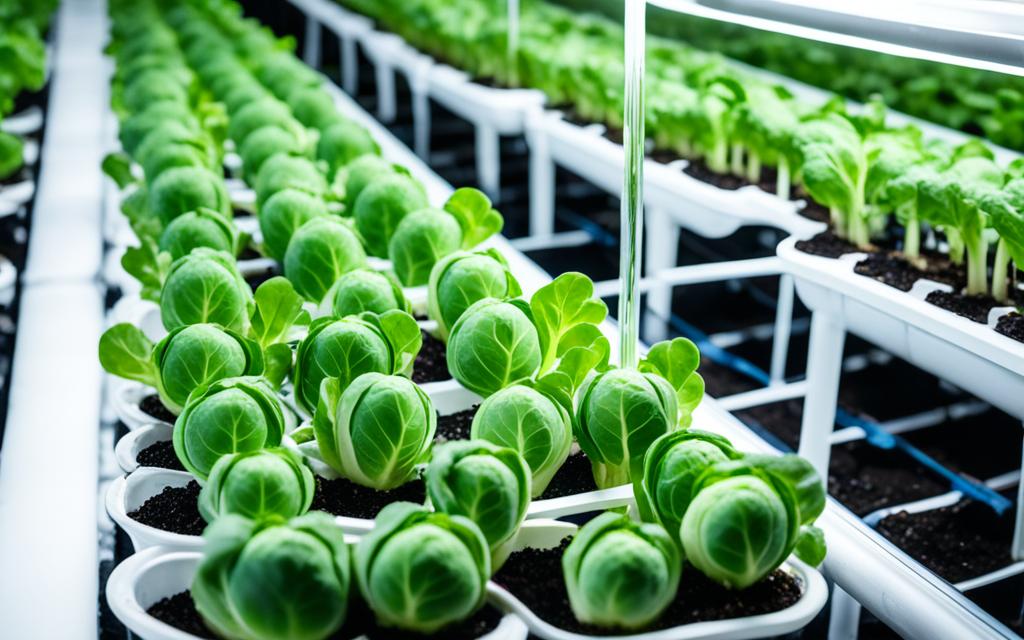
“Hydroponic cultivation allows me to grow Brussels sprouts with unparalleled consistency and quality, regardless of the season or weather conditions.”
Setting Up Your Hydroponic System
Choosing the right hydroponic system is key to growing Brussels sprouts successfully. You can pick from systems like deep water culture (DWC) or ebb and flow. Each system has its own benefits, like simplicity or control, so pick the one that fits your needs and space.
Choosing the Right Hydroponic System
The DWC system is a top pick for growing Brussels sprouts hydroponically. It keeps roots in a nutrient-rich solution, giving plants steady nutrients and consistent conditions. It’s easy to set up and maintain, perfect for beginners.
The ebb and flow system is another good choice. It floods the growing tray with nutrients, then drains it, letting roots absorb what they need. This system gives more control, ideal for those with more experience.
Essential Equipment and Supplies
No matter the system, you’ll need certain gear for your Brussels sprouts garden. This includes:
- Grow lights for the plants’ light needs
- Air pumps for the nutrient solution’s oxygen
- pH and EC meters to keep conditions right
- Nutrient solutions made for hydroponic Brussels sprouts
- Growing media like rockwool or coco coir for the roots
With the right system and gear, you’re set to grow a successful hydroponic Brussels sprouts garden.
Selecting and Preparing Plants
Choosing the right Brussels sprout varieties is key to growing them well in hydroponics. ‘Jade Cross’, ‘Catskill’, and ‘Hestia’ are top picks. They grow well indoors, resist diseases, and produce a lot, perfect for hydroponics.
Growers can start with seeds or use seedlings. It’s important to get seeds to germinate and harden off seedlings. This makes sure they adjust to hydroponic conditions, setting them up for great growth and lots of sprouts.
Best Best Brussels sprout varieties for hydroponics
- ‘Jade Cross’ – Compact plants with high yields and good disease resistance
- ‘Catskill’ – Reliable performer with a sweet, nutty flavor
- ‘Hestia’ – Productive variety with a sturdy, upright growth habit
| Variety | Growth Habit | Flavor Profile | Yield Potential |
|---|---|---|---|
| ‘Jade Cross’ | Compact | Sweet, nutty | High |
| ‘Catskill’ | Upright | Mild, sweet | Moderate |
| ‘Hestia’ | Sturdy, upright | Slightly bitter | High |
Choosing the right Brussels sprout varieties and preparing them well sets the stage for a great hydroponic harvest. This ensures a successful and rewarding grow.
Germination and Transplanting
Starting a successful hydroponic Brussels sprouts garden is key. It begins with the right germination and transplanting steps. Growing top-quality hydroponic Brussels sprouts seedlings is crucial for a great harvest.
First, Brussels sprouts seeds are germinated in a good medium, like rockwool. This ensures the right temperature and moisture. When the seedlings have their first true leaves, it’s time to transplant them into the hydroponic setup. Make sure they have enough space to grow well.
- Germinate Brussels sprouts seeds in a special medium like rockwool, keeping the temperature and moisture just right.
- Watch the seedlings closely, and move them to the hydroponic system when they have their first true leaves.
- Put the Brussels sprouts seedlings far enough apart to let them grow and develop well.
Getting germination and transplanting right is key for a strong and fruitful hydroponic Brussels sprouts garden. By doing these steps well, growers can look forward to a big harvest of tasty Brussels sprouts.
Nutrient Management and Fertilizer
Proper nutrient management is key for hydroponic Brussels sprouts to grow well. These greens need specific nutrients that must be watched closely. This ensures they perform their best.
Essential Nutrients for Hydroponic Brussels Sprouts
The main nutrients for hydroponic Brussels sprouts are:
- Nitrogen (N) – Helps with leaf growth and development
- Phosphorus (P) – Boosts root growth and plant health
- Potassium (K) – Makes plants more resistant to disease and stress
- Calcium (Ca) – Makes cell walls strong and improves sprout quality
- Magnesium (Mg) – Helps make chlorophyll and absorb nutrients
Preparing Nutrient Solutions
Growers must prepare and check the nutrient solution’s pH and EC levels. This ensures plants take in nutrients well. The hydroponic Brussels sprouts nutrients should be mixed right, considering the Brussels sprouts hydroponic nutrient requirements. It’s vital to mix the nutrients correctly for a balanced supply of essential elements.
By knowing what nutrients hydroponic Brussels sprouts need and managing them well, growers can help plants grow and produce lots of food.
Light and Temperature Requirements
Cultivating hydroponic Brussels sprouts needs careful attention to their light and temperature needs. These factors are key for the health and productivity of your hydroponic garden.
Choosing the Right Grow Lights
LED grow lights are a great choice for hydroponic Brussels sprouts. They are energy-efficient and provide the right hydroponic Brussels sprouts lighting. This is because they give off a wide range of light that is similar to natural sunlight. The Brussels sprouts grow light requirements include 12-14 hours of light daily, with an ideal intensity of 400-600 μmol/m²/s.
When picking grow lights, choose ones made for leafy greens and brassicas. They give the right light spectrum and intensity for your hydroponic Brussels sprouts.
Maintaining the Ideal Temperature
The temperature for hydroponic Brussels sprouts should be kept between 60-70°F (15-21°C). This range helps with healthy growth, makes the Brussels sprouts compact and tasty, and prevents them from flowering too early.
Use climate-controlled grow tents or greenhouses for steady temperatures. Be ready to adjust as needed to keep up with changes in the environment.
Monitoring and Adjusting Growing Conditions
For growing Brussels sprouts in hydroponics, it’s key to keep the conditions just right. You need to check and tweak the pH and electrical conductivity (EC) of the nutrient solution often. This makes sure your Brussels sprouts grow well.
pH and EC Levels
The perfect pH for hydroponic Brussels sprouts is between 5.5 and 6.5. The best EC level is usually 1.5 to 2.5. Keeping an eye on these levels and adjusting them helps fix any nutrient deficiencies or imbalances. This ensures your Brussels sprouts get the best care.
| Parameter | Ideal Range | Impact on Plant Growth |
|---|---|---|
| pH | 5.5 – 6.5 | Affects nutrient availability and uptake |
| EC | 1.5 – 2.5 | Indicates the concentration of dissolved nutrients |
By closely monitoring and adjusting the pH and EC levels, you can make sure your Brussels sprouts have the best hydroponic conditions. This leads to healthy plants and more yield.
hydroponic Brussels Sprouts Growth Stages
Growing hydroponic Brussels sprouts is rewarding. It requires watching the plants go through different growth stages. Knowing these stages helps give the plants the care they need for a big harvest.
The stages of hydroponic Brussels sprouts growth include:
- Seed Germination: The process starts with the seeds germinating. Seedlings grow and develop their roots and leaves.
- Seedling Establishment: As seedlings grow, they need special care. They are moved to the hydroponic system and get the best growing conditions.
- Vegetative Growth: In this phase, the plants grow leaves. This prepares them for making sprouts.
- Sprout Development: This is the highlight of the Brussels sprouts growth cycle in hydroponics. Sprouts grow and get ready to be picked.
Watching the hydroponic Brussels sprouts development closely is key. Adjusting how you grow them is important for a good harvest.
| Growth Stage | Key Characteristics | Recommended Care |
|---|---|---|
| Seed Germination | – Seed sprouting and root emergence – Initial leaf development | – Maintain optimal temperature and humidity – Provide adequate moisture |
| Seedling Establishment | – Transplanting into hydroponic system – Continued leaf and root growth | – Ensure proper nutrient balance – Adjust lighting and temperature as needed |
| Vegetative Growth | – Robust foliage development – Preparation for sprout production | – Monitor and maintain optimal pH and EC levels – Prune and train the plants as necessary |
| Sprout Development | – Emergence and maturation of sprouts – Potential for multiple harvests | – Ensure adequate light and temperature – Harvest sprouts at the right stage of maturity |
By understanding and meeting the needs of each growth stage, hydroponic growers can grow healthy Brussels sprouts. This leads to a big harvest.
Common Issues and Troubleshooting
Growing hydroponic Brussels sprouts can be rewarding, but you might face common issues. Nutrient deficiencies are a big problem, showing up in different ways. They can hurt your plants’ health and how much they produce. By knowing how to spot and fix these imbalances, your hydroponic Brussels sprouts will do great.
Identifying and Addressing Nutrient Deficiencies
Nutrient problems in hydroponic Brussels sprouts come from many things like nutrient solution imbalances, pH changes, or the environment. Watch your plants closely to catch any nutrient issues early. Look for signs like:
- Yellowing or discolored leaves
- Stunted growth or wilting
- Reduced leaf size or deformation
- Delayed or poor head formation
After spotting a problem, fix the nutrient imbalance. This could mean changing your nutrient solution, adjusting the pH, or adding supplements. By acting fast and making the right changes, your Brussels sprouts will get better and keep growing well.
“Proper nutrient management is crucial for the success of your hydroponic Brussels sprouts garden. With a little troubleshooting, you can overcome common issues and enjoy a bountiful harvest.”
Fixing nutrient deficiencies in hydroponic Brussels sprouts is key to solving problems and keeping your plants healthy. By knowing the signs of nutrient issues and acting quickly, you can make sure your hydroponic Brussels sprouts grow well and give you lots of quality produce.
Pest and Disease Management
Hydroponic systems help reduce the risk of pests and diseases from soil. But, growers must still watch for and deal with any problems. Using pest and disease management strategies is key for keeping hydroponic Brussels sprouts healthy and productive.
One important method is integrated pest management (IPM). This means using different ways to control pests, such as:
- Introducing beneficial insects that eat common pests
- Using organic pesticides carefully to solve specific issues
- Keeping optimal growing conditions to stop pests and diseases
It’s important to check on plants often and catch problems early. Growers should look for signs of pest infestations or disease outbreaks, like spots on leaves, wilting, or strange growth.
With a good disease management strategy and constant watch, hydroponic Brussels sprout growers can keep their crops healthy and productive all season.
“Proactive pest and disease management is the key to a bountiful hydroponic Brussels sprout harvest.”
Harvesting Your Hydroponic Brussels Sprouts
Knowing when and how to harvest hydroponic Brussels sprouts is key for a great crop. Start checking the sprouts from the bottom of the plant and move up. This helps you catch them at their best.
The best time to harvest hydroponic Brussels sprouts is when they’re firm and bright green. This is usually 90-120 days after you planted them, based on the type and growing conditions. When you’re ready to pick, use a sharp knife or pruners to cut the stems. Don’t pull the sprouts to avoid hurting the plant and cutting down on future harvests.
- Cut the sprouts from the bottom of the plant, working your way upwards.
- Ensure the sprouts are firm and bright green, with no signs of yellowing or wilting.
- Use a sharp knife or pruners to cut the stems, leaving about an inch of stem attached to the sprout.
- Handle the harvested sprouts gently to avoid bruising or damage.
By following these tips for harvesting Brussels sprouts grown hydroponically, growers can ensure a successful and continuous harvest. This way, they get the most out of their hydroponic crop.
| Harvest Characteristic | Optimal Condition |
|---|---|
| Sprout Firmness | Firm |
| Sprout Color | Bright Green |
| Harvest Method | Cut Stems, Leave 1 inch Attached |
| Harvest Timing | 90-120 Days After Transplanting |
“Proper harvesting techniques are essential for ensuring a successful and continuous hydroponic Brussels sprout harvest.”
Tips for Maximizing Yield
Getting the most out of your hydroponic Brussels sprouts is the main aim. By using certain methods, you can boost the hydroponic Brussels sprouts yield and maximize Brussels sprouts production in hydroponics. A crucial approach is to focus on pruning and training hydroponic Brussels sprouts.
Pruning and Training Techniques
Pruning and training your hydroponic Brussels sprouts plants can greatly improve light penetration. This helps in making the sprouts bigger and better. Here are some key tips:
- Remove lower leaves: Take off the lower leaves to let more light reach the sprouts.
- Guide the main stem: Use soft ties or clips to keep the main stem upright and straight. This boosts the yield.
- Pinch off terminal buds: Removing the top buds makes side shoots grow, giving you more sprouts.
- Prune suckers: Take out any side shoots that form to keep the plant’s energy on the main sprouts.
Keep an eye on your plants, make adjustments as needed, and pay close attention for the best yields. By using these pruning and training methods, you can maximize your hydroponic Brussels sprouts plants’ potential and get a big harvest.
Expanding Your Hydroponic Garden
After learning how to grow hydroponic Brussels sprouts, think about adding more vegetables and plants that grow well hydroponically to your garden. Great choices include asparagus, spinach, aloe vera, and kale. Each one brings its own benefits and growth style. Adding more to your hydroponic garden means you can have a variety of fresh, healthy food easily.
Other Suitable Plants for Hydroponic Growing
Hydroponic gardening lets you grow many plants that grow well hydroponically. Here are some more plants you might want for your expanding hydroponic garden:
- Asparagus – A perennial vegetable that does great in hydroponic systems, giving you lots of tender spears.
- Spinach – A leafy green that’s full of nutrients and grows fast in hydroponics.
- Aloe Vera – Not just for medicine, aloe vera can be grown hydroponically, making your garden more interesting and useful.
- Kale – A superfood full of vitamins and minerals, kale is a top pick for hydroponic growing.
Adding these and other vegetables for hydroponic growing to your hydroponic garden means you’ll have a lot of fresh, tasty food ready to eat.
Conclusion
Growing hydroponic Brussels sprouts at home is rewarding and sustainable. It lets you enjoy this nutrient-rich vegetable all year. This article guides gardeners on setting up a hydroponic system, picking the best varieties, and managing nutrients and conditions.
It also helps with troubleshooting common issues for a big harvest of fresh, tasty Brussels sprouts.
With patience and attention to detail, hydroponic Brussels sprouts can be a great addition to your garden. The conclusion on growing hydroponic Brussels sprouts is that it’s a controlled and efficient way to grow this versatile crop. It ensures a steady supply of healthy, high-quality produce right at your fingertips.
The summary of hydroponic Brussels sprouts cultivation in this article gives gardeners a roadmap to start hydroponic gardening. By using the techniques and insights shared, home growers can enjoy a steady harvest of delicious, nutritious Brussels sprouts. These will delight your taste buds and inspire your cooking.
